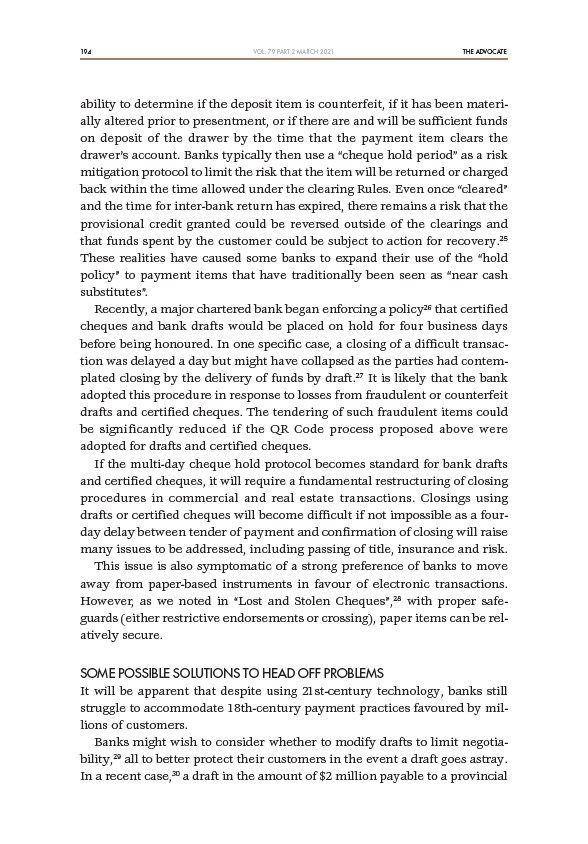
194 THE ADVOCATE
VOL. 79 PART 2 MARCH 2021
ability to determine if the deposit item is counterfeit, if it has been materially
altered prior to presentment, or if there are and will be sufficient funds
on deposit of the drawer by the time that the payment item clears the
drawer’s account. Banks typically then use a “cheque hold period” as a risk
mitigation protocol to limit the risk that the item will be returned or charged
back within the time allowed under the clearing Rules. Even once “cleared”
and the time for inter-bank return has expired, there remains a risk that the
provisional credit granted could be reversed outside of the clearings and
that funds spent by the customer could be subject to action for recovery.25
These realities have caused some banks to expand their use of the “hold
policy” to payment items that have traditionally been seen as “near cash
substitutes”.
Recently, a major chartered bank began enforcing a policy26 that certified
cheques and bank drafts would be placed on hold for four business days
before being honoured. In one specific case, a closing of a difficult transaction
was delayed a day but might have collapsed as the parties had contemplated
closing by the delivery of funds by draft.27 It is likely that the bank
adopted this procedure in response to losses from fraudulent or counterfeit
drafts and certified cheques. The tendering of such fraudulent items could
be significantly reduced if the QR Code process proposed above were
adopted for drafts and certified cheques.
If the multi-day cheque hold protocol becomes standard for bank drafts
and certified cheques, it will require a fundamental restructuring of closing
procedures in commercial and real estate transactions. Closings using
drafts or certified cheques will become difficult if not impossible as a fourday
delay between tender of payment and confirmation of closing will raise
many issues to be addressed, including passing of title, insurance and risk.
This issue is also symptomatic of a strong preference of banks to move
away from paper-based instruments in favour of electronic transactions.
However, as we noted in “Lost and Stolen Cheques”,28 with proper safeguards
(either restrictive endorsements or crossing), paper items can be relatively
secure.
SOME POSSIBLE SOLUTIONS TO HEAD OFF PROBLEMS
It will be apparent that despite using 21st-century technology, banks still
struggle to accommodate 18th-century payment practices favoured by millions
of customers.
Banks might wish to consider whether to modify drafts to limit negotiability,
29 all to better protect their customers in the event a draft goes astray.
In a recent case,30 a draft in the amount of $2 million payable to a provincial